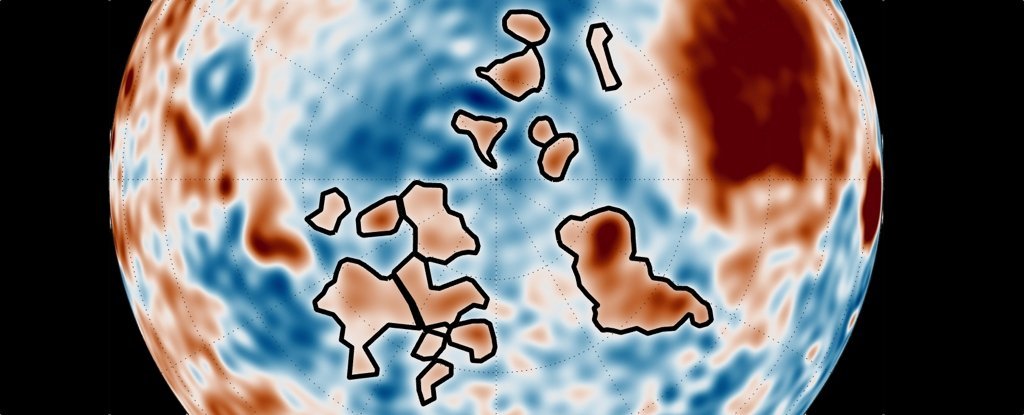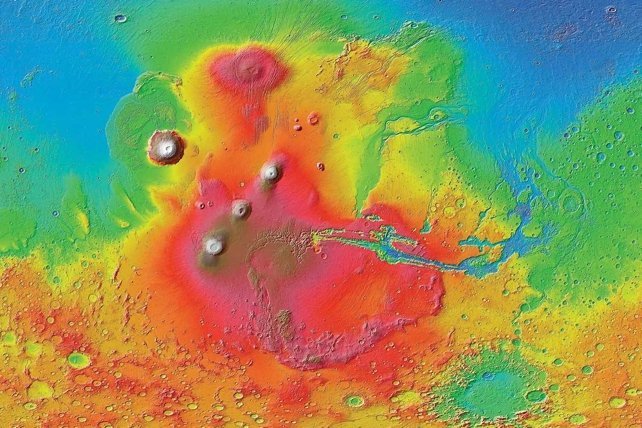In a recent discovery, scientists have identified hidden, dense structures beneath the surface of Mars, providing fresh insights into the planet’s geological and volcanic activity.
These findings, presented by Bart Root from Delft University of Technology at the Europlanet Science Congress (EPSC) in Berlin, shed light on previously unknown features beneath Mars’ northern polar plains and the Tharsis volcanic region.

Research combining data from multiple space missions and advanced modeling techniques has revealed massive subterranean features that could be volcanic in origin or remnants of ancient impacts.
One such discovery includes a vast, lightweight structure beneath the Tharsis region, home to Olympus Mons, the Solar System’s largest volcano.
This structure spans approximately 1,750 kilometers wide and is located about 1,100 kilometers below the surface, causing the Tharsis area to bulge upwards.
Dr. Root explained, “These dense structures could be volcanic in origin or compacted material from ancient impacts. We’ve identified about 20 features scattered around the area near the north polar cap, one resembling the shape of a dog. While there seems to be no evidence of these features at the surface, gravity data provides an intriguing glimpse into the older history of Mars’ northern hemisphere.”
The density map revealed that these features are denser by about 300-400 kg/m³ compared to their surroundings.
This significant finding points to ongoing active processes within Mars’ mantle that may be contributing to the formation of new volcanic features.

Bart Root and his team utilized minute deviations in the orbits of satellites to investigate Mars’ gravity field.
This data was then integrated into advanced models incorporating new findings from NASA’s InSight mission, which revealed crucial details about the thickness and flexibility of Mars’ crust and the dynamics of its mantle.
Scientists have long debated Mars’ volcanic activity. Although there are no active volcanoes on the planet, recent studies suggest the Tharsis region may have undergone resurfacing in the geologically recent past.
This suggests that Mars might still be volcanically active, with potential future eruptions.
“The NASA InSight mission has provided us with crucial new data about Mars’ rigid outer layer, forcing us to rethink our understanding of how Olympus Mons and its surrounding region are supported. It suggests that Mars might still be experiencing active movements in its interior,” Dr. Root added.
The newfound gravity anomalies have also sparked discussions regarding the need to rethink a fundamental geological concept known as flexural isostasy.
This concept typically explains how a planet’s outer rigid layer, the lithosphere, responds to large-scale loading and unloading by sinking and causing an uplift in surrounding areas.
However, the elevated nature of Tharsis Montes contradicts this idea, indicating the presence of an active mantle plume strong enough to counteract the downward pressure from the massive volcanic region.
To explore these hidden structures and further advance our understanding of Mars’ interior, Dr. Lisa Wörner from DLR proposed the Martian Quantum Gravity (MaQuls) mission.
This mission, based on technology used in the GRAIL and GRACE missions that mapped the Moon’s and Earth’s gravity, aims to gather detailed gravity data using two satellites connected by an optical link.
“Observations with MaQuIs would enable us to better explore the subsurface of Mars, helping us uncover more about these mysterious features and study ongoing mantle convection, as well as dynamic surface processes like atmospheric changes and groundwater reservoirs,” Dr. Wörner stated.
While the Martian landscape continues to fascinate scientists and enthusiasts alike, these recent discoveries underline that Mars remains an active and dynamically changing planet, with many secrets yet to be uncovered beneath its surface.
